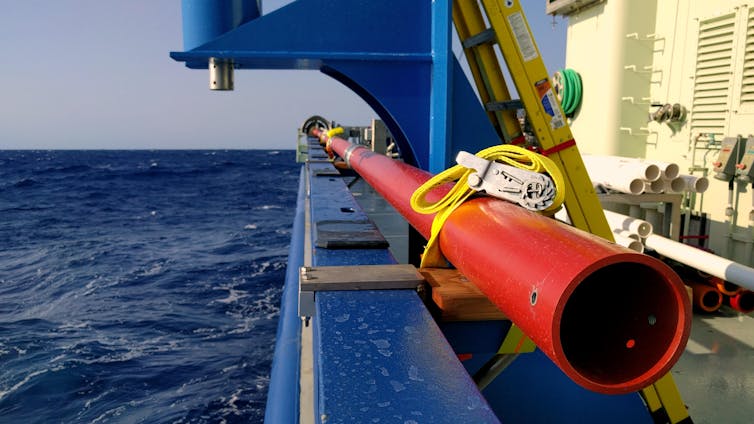Twenty thousand years ago, the world was locked into a great ice age. Ice sheets two miles thick covered much of North America, Scandinavia, and the British Isles.
Greenhouse gas concentrations were much lower, the world was 6°C cooler, and because of all the water trapped in the ice sheets, the seas were at least 120 meters lower, exposing the land that is submerged today. It would be possible to walk from France to London via Doggerland or from Russia to Alaska via Beringia.
But our research, now published in Nature , has revealed at least one surprise in the Ice Age climate: The Gulf Stream, which carries warm water northward across the Atlantic, was stronger and deeper than it is today.
This research came about because, as paleoceanographers (scientists who study the oceans of the past), we wanted to understand how the oceans behaved during the last ice age to gain insight into how climate change might change things in the future.
Warm water – from Mexico to Norway
Today, warm, salty water from the Gulf of Mexico flows north as part of the Gulf Stream. Part of it flows through Europe and gives off a lot of heat, keeping the climate of Western Europe very mild.
Tooth et al (2023) Authorea Preprints / WHOI Creative Studio
Then, as the surface water flows north of Iceland, it loses enough heat to increase its density, causing it to sink and form deep water. This process initiates a global deep-sea conveyor belt that connects all of the world’s oceans and slowly transports heat around the planet at depths greater than a mile below the surface.
Scientists previously believed that the Atlantic meridional overturning circulation — a complex system of deep and surface ocean currents, including the Gulf Stream — was weaker during extremely cold periods such as the last ice age. In theory, more sea ice in the Arctic would reduce the amount of water sinking from the surface into the deep ocean, slowing down the global deep-sea conveyor belt.
But our new study reveals that the Gulf Stream was actually much stronger (and deeper) during the last ice age. This is despite the prevailing cold glacial climate and the presence of huge ice sheets around the northern parts of the Atlantic.
In fact, our research suggests that the glacial climate itself was responsible for driving the stronger Gulf Stream. In particular, the Ice Age was characterized by much stronger winds over parts of the North Atlantic that would have driven a stronger Gulf Stream. Therefore, even though the amount of water sinking from the surface to the ocean depths decreased, the Gulf Stream was stronger and still carried a lot of heat north, although not as far as today.
Reconstruction of past ocean circulation
Because we have no data from meteorological buoys or satellites, we instead reconstructed how the ocean would have circulated during the last ice age using proxy evidence preserved in marine sediment cores, which are long tubes of mud from the ocean floor.
The cores we used contained mud that had accumulated on the sea floor over the past 25,000 years and were retrieved from various locations along the US East Coast using research vessels from the Woods Hole Oceanographic Institution in Massachusetts, where some of our team is based.

Christopher Griner / Woods Hole Oceanographic Institution
To determine the strength of the Gulf Stream during the Ice Age, we measured the size of the sediment grains in the mud, with larger grains indicating faster flow and vice versa.
From the same mud, we also measured the chemistry of the shells of tiny single-celled organisms called foraminifera. By comparing data from different depths at different locations in the northwest Atlantic, we were able to identify the boundary between foraminifera that once lived in warm subtropical waters and those that lived in cooler subpolar waters. This allowed us to determine the depth of the Gulf Stream at the time these organisms were alive.
This increases the uncertainty of climate projections
Our research highlights how sensitive the Gulf Stream and the wider Atlantic current system are to changes in wind strength as well as melting water from the Greenland ice sheet. This has important implications for future climate change.
Climate models predict that the Gulf Stream will weaken during the 21st century, in part due to reduced winds. This would lead to even higher sea levels along the US East Coast and relatively less global warming in Europe. If climate change causes changes in wind patterns in the future, the Gulf Stream will also change, adding to uncertainty about future climate conditions.
Our results also highlight why we should not make simplistic statements about Atlantic currents and future climate change. The Atlantic represents a set of interconnected currents, each with its own behavior and unique response to climate change. Therefore, when explaining the impact of anthropogenic climate change on the climate system, we need to be very clear about which part we are discussing and the specific implications for different countries.